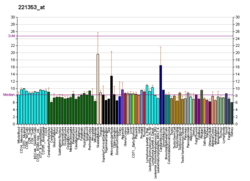OR3A1
Olfactory receptor 3A1 is a protein that in humans is encoded by the OR3A1 gene.[4][5][6]
| OR3A1 | |||||||||||||||||||||||||
|---|---|---|---|---|---|---|---|---|---|---|---|---|---|---|---|---|---|---|---|---|---|---|---|---|---|
| Identifiers | |||||||||||||||||||||||||
| Aliases | OR3A1, OLFRA03, OR17-40, OR17-82, OR40, olfactory receptor family 3 subfamily A member 1, olfactory receptor family 3 subfamily A member 1 (gene/pseudogene) | ||||||||||||||||||||||||
| External IDs | MGI: 3030236 HomoloGene: 1915 GeneCards: OR3A1 | ||||||||||||||||||||||||
| |||||||||||||||||||||||||
| |||||||||||||||||||||||||
| |||||||||||||||||||||||||
| Orthologs | |||||||||||||||||||||||||
| Species | Human | Mouse | |||||||||||||||||||||||
| Entrez | |||||||||||||||||||||||||
| Ensembl |
| ||||||||||||||||||||||||
| UniProt | |||||||||||||||||||||||||
| RefSeq (mRNA) | |||||||||||||||||||||||||
| RefSeq (protein) | |||||||||||||||||||||||||
| Location (UCSC) | Chr 17: 3.29 – 3.3 Mb | n/a | |||||||||||||||||||||||
| PubMed search | [2] | [3] | |||||||||||||||||||||||
| Wikidata | |||||||||||||||||||||||||
| |||||||||||||||||||||||||
Olfactory receptors interact with odorant molecules in the nose, to initiate a neuronal response that triggers the perception of a smell. The olfactory receptor proteins are members of a large family of G-protein-coupled receptors (GPCR) arising from single coding-exon genes. Olfactory receptors share a 7-transmembrane domain structure with many neurotransmitter and hormone receptors and are responsible for the recognition and G protein-mediated transduction of odorant signals. The olfactory receptor gene family is the largest in the genome. The nomenclature assigned to the olfactory receptor genes and proteins for this organism is independent of other organisms.[6]
Ligands
OR3A1 is activated by helional and the closely related molecule heliotropylacetone.[7] Other compounds including piperonal, safrole, and vanillin completely failed to activate OR3A1.
Agonists:
- helional[7]
- heliotropylacetone[7]
- lilial[8]
- cyclamen aldehyde[8]
- foliaver (3-(4-methoxyphenyl)-2-methylpropanal)[8]
See also
References
- GRCh38: Ensembl release 89: ENSG00000180090 - Ensembl, May 2017
- "Human PubMed Reference:". National Center for Biotechnology Information, U.S. National Library of Medicine.
- "Mouse PubMed Reference:". National Center for Biotechnology Information, U.S. National Library of Medicine.
- Glusman G, Clifton S, Roe B, Lancet D (October 1996). "Sequence analysis in the olfactory receptor gene cluster on human chromosome 17: recombinatorial events affecting receptor diversity". Genomics. 37 (2): 147–60. doi:10.1006/geno.1996.0536. PMID 8921386.
- Crowe ML, Perry BN, Connerton IF (March 1996). "Olfactory receptor-encoding genes and pseudogenes are expressed in humans". Gene. 169 (2): 247–9. doi:10.1016/0378-1119(95)00849-7. PMID 8647456.
- "Entrez Gene: OR3A1 olfactory receptor, family 3, subfamily A, member 1".
- Sanz G, Schlegel C, Pernollet JC, Briand L (January 2005). "Comparison of odorant specificity of two human olfactory receptors from different phylogenetic classes and evidence for antagonism". Chemical Senses. 30 (1): 69–80. doi:10.1093/chemse/bji002. PMID 15647465.
- Jacquier V, Pick H, Vogel H (April 2006). "Characterization of an extended receptive ligand repertoire of the human olfactory receptor OR17-40 comprising structurally related compounds". Journal of Neurochemistry. 97 (2): 537–44. doi:10.1111/j.1471-4159.2006.03771.x. PMID 16539658.
Further reading
- Marrakchi M, Vidic J, Jaffrezic-Renault N, Martelet C, Pajot-Augy E (November 2007). "A new concept of olfactory biosensor based on interdigitated microelectrodes and immobilized yeasts expressing the human receptor OR17-40". European Biophysics Journal. 36 (8): 1015–8. doi:10.1007/s00249-007-0187-6. PMID 17579849.
- Jacquier V, Prummer M, Segura JM, Pick H, Vogel H (September 2006). "Visualizing odorant receptor trafficking in living cells down to the single-molecule level". Proceedings of the National Academy of Sciences of the United States of America. 103 (39): 14325–30. doi:10.1073/pnas.0603942103. PMC 1599963. PMID 16980412.
- Malnic B, Godfrey PA, Buck LB (February 2004). "The human olfactory receptor gene family". Proceedings of the National Academy of Sciences of the United States of America. 101 (8): 2584–9. doi:10.1073/pnas.0307882100. PMC 356993. PMID 14983052.
- Glusman G, Sosinsky A, Ben-Asher E, Avidan N, Sonkin D, Bahar A, et al. (January 2000). "Sequence, structure, and evolution of a complete human olfactory receptor gene cluster". Genomics. 63 (2): 227–45. doi:10.1006/geno.1999.6030. PMID 10673334.
- Ben-Arie N, Lancet D, Taylor C, Khen M, Walker N, Ledbetter DH, et al. (February 1994). "Olfactory receptor gene cluster on human chromosome 17: possible duplication of an ancestral receptor repertoire". Human Molecular Genetics. 3 (2): 229–35. doi:10.1093/hmg/3.2.229. PMID 8004088.
External links
- OR3A1+protein,+human at the US National Library of Medicine Medical Subject Headings (MeSH)
This article incorporates text from the United States National Library of Medicine, which is in the public domain.


